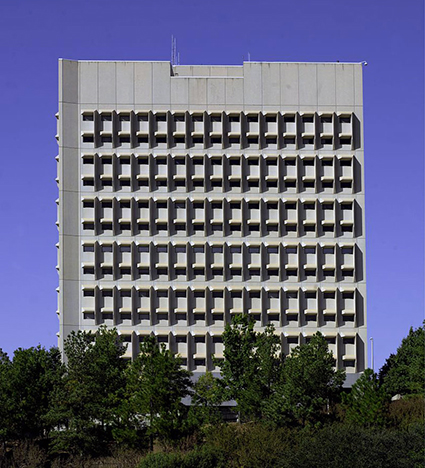by the WBDG Commissioning Committe
Within This Page
Introduction
Existing-Building Commissioning (EBCx) is similar in intent to new construction commissioning (NCCx). Its purpose is to investigate, verify, improve, and optimize system performance. However, because Owners and project stakeholders are planning and executing the process within an operating—or even occupied—facility, the process differs in both scope and sequence.
Like the NCCx Owner's Project Requirements (OPR), EBCx depends upon starting and ending with an up-to-date Current Facility Requirements (CFR) for the systems and equipment being commissioned. The end result of both new and existing building commissioning is a defined and documented facility and/or equipment that is performing as intended.
EBCx assists in delivering efficient and effective operation of systems that provide an efficient, safe and healthy facility; optimize energy and water use; and reduce operating costs. CxPs facilitate O&M staff orientation and training; and also prepare and improve installed building systems documentation.
There can be many reasons for EBCx. The level of commissioning activity is based on the Owner's intent to, for example, address operating and performance concerns; replace or update aging equipment; take advantage of utility incentive programs; upgrade asset value; make occupancy space and system changes, or comply with regulatory requirements or efficiency goals.
The scope of commissioning will determine the approach, details, and plans for the specific project. This scope may range from a building "tune-up" to full and integrated replacement and commissioning of some or all building systems. In the case of portfolio Owners, EBCx may be conducted simultaneously on more than one facility to support broader systems integration.

Some existing buildings in the federal portfolio such as the Strom Thurmond Federal Building and U.S. Courthouse in Columbia, South Carolina, are from an era of buildings that were not designed to last more than 20–30 years. These buildings get evaluated for various renovations including systems upgrades due to their age and typical short lifespan. Photo Credit: Carol M. Highsmith / GSA.
The purpose and scope of EBCx is contained within one or more of these definitions:
Retro-commissioning (RCx) is commissioning an existing building that has never been commissioned before.
Recommissioning (ReCx) occurs when a building that has already been commissioned undergoes another commissioning process. The decision to recommission may be triggered by a change in building use or Ownership, the onset of operational problems, or some other need.
Monitoring-Based Commissioning (MBCx) utilizes primarily monitored data (versus primarily manual tests and checks) originating from the Building Automation System (BAS) or other meters processed with special analysis tools, sometimes referred to as Energy Management and Information Systems (EMIS).
System-Specific Commissioning is a tailored application focused on a small subset of targeted systems in a building, such as indoor environmental quality or chiller plant efficiency.
Ongoing Commissioning (OCx) continuously gathers data about existing systems and building performance and continuously or regularly evaluates the data to ensure proper operation and to improve performance, usually dependent on hardware and software tracking tools and by a separate contractual arrangement after completion of NCCx or EBCx.
Additional details can be found in the BCxA/APPA Building Commissioning Handbook (third edition), the BCxA Existing Building Commissioning Best Practices, and in ASHRAE Guideline 0.2–2015 Commissioning Process for Existing Systems and Assemblies.

Commissioning an existing building and its systems requires a different process than new construction as outlined below. Photo Credit: FEMP
EBCx Process Description
EBCx is generally conducted in five phases, described as follows. In small projects, Phase 2 Initial Assessment and Phase 3 Investigation often occur together:
Planning. Initial project documentation gathering and assessment forms the basis for developing the EBCx goals, facility requirements, and Commissioning Plan. The initiation of EBCx begins with basic planning for the process by the Owner or responsible staff to determine the scope of the project, and to work with the CxP to develop the intended commissioning procedures.
The EBCx process cannot succeed unless the current intent and performance requirements for the system and building are defined. This is documented for each facility in the Current Facility Requirements (CFR) document developed by the Owner or Operator of the building. The CFR is often similar to the initial OPR but may vary due to changes in building or system usage and function or equipment modifications. These requirements need to be current for EBCx to proceed and be successful. After the CFR is defined, an initial assessment of the equipment and facility is conducted to determine the current status and apparent operating conditions and if those items appear to meet the CFR.
Initial Assessment. Initial walk-through of the building to note and confirm current condition of systems and equipment, document known issues, identify other potential issues, interview building staff and occupants, and prepare an initial EBCx Plan. This may include an assessment of building trends and a review of known operational issues and work orders.
Investigation. Field observation and testing of system operation, interviewing facility staff, reviewing equipment and building documentation, confirmation of adequate preventive maintenance plans, evaluating sequences of operation, deeper evaluation of BAS trends, or logging data of equipment operation, documenting findings and identifying ECMs and FIMs, and estimating energy impacts and costs.
Implementation. Initiation and completion of desired energy conservation measures (ECMs) and facility improvement measures (FIMs), and verification of results and performance. At completion, the systems and/or integrated systems are commissioned and tested to determine actual performance compared to the newly-updated CFR.
Hand-Off. Systematic transition from a commissioning activity and commissioning team to normal operating practice and the O&M team. The updated Systems Manual and commissioning reports are generated and include updated documentation. Measures for persistence of performance are developed, including preventive maintenance requirements, training of facility managers, operations and maintenance staff and occupants, and performance tracking, and may include plans for ongoing commissioning (OCx).
During the hand-off phase, a formal training session helps users to understand the EBCx findings, the how and why of implemented changes, as well as the methods to control and maintain integrated systems. EBCx training may also include the occupants for ECMs and FIMs that impact or are directly controlled by the end-users, such as upgraded thermostats or lighting controls. Training is based on the systems' sequences of operation, the operations guide and the O&M manuals as the primary sources of information.
Technical and technology application training for OCx may begin at this phase, or earlier for integrated EBCx+OCx projects. Training includes content that familiarizes the staff and/or other involved parties with the navigation and features of the technology product(s) and advanced tasks required to use and apply data analytics.
BCxA training plans, agendas and instructions and Commissioning for Existing Federal Buildings provide useful tools for conducting hands-on EBCx training.
Commissioning Team Engagement
Commissioning is a team effort to document the continuity of a building project along with its performance as it moves from one EBCx project phase to the next. Designated team members are responsible for specific activities and documents during the various phases. The commissioning team always includes the Owner or representative that is ultimately responsible for the project success including the commissioning.
The EBCx Team content will vary by Owner requirements and project scope. It is essential to designate a CxP, experienced in the facility type and systems to be addressed, at the inception of the planning process to manage the team and the EBCx process to completion. This will provide continuity, communication and guidance between the Owner's team and the Cx Team members. Specific EBCx team functions and participants will vary during the project and may include:
Owner/Owner's Representative The participation and process management by the project Owner is absolutely essential to the success of the commissioning process and the project. From detailing the project requirements in the CFR along with budgets and schedules to selection of the CxP, the Owner's role also includes review and acceptance of the many commissioning documents during the project, plus acceptance of the commissioning report and the resultant project performance. Documents of particular importance to the Owner are the pre- and post- project CFR, Assessment Plan and Report, Verification Plan and Report, Implementation Documents, Commissioning Plans, and Reports. This role may be executed by the true Owner or by an officially designated Owner's representative. Because of the importance of the Owner's function, it is essential that the designated representative be available and actively engaged in the project from planning through completion to meet project requirements along with schedules and budgets.
Commissioning Provider The CxP is the general manager of the commissioning process. The commissioning process works best if the CxP is hired by the Owner at the very beginning of the project. The CxP, working for the Owner, represents the Owner's interests and provides an asset for the Project Team in producing a functional building that meets the Owner's requirements. At the beginning of the project, the CxP assists the Owner in planning and developing the CFR, reviews the facility design documents, and assists in the development of the Assessment, Verification and Implementation Plans. During the EBCx process, the CxP, along with other members of the commissioning team, updates the plans and system checklists, conducts the commissioning meetings, conducts observations and witnesses contractor equipment verification and testing, produces and updates the issues and resolutions logs, reviews the Systems Manual and process phase reports, and produces the commissioning reports. If training is included in the project scope, the CxP may prepare or review training curriculum and conduct or observe training.
Other EBCx Team Members Depending upon project requirements and Owner's process, many other entities participate in the project and commissioning process. Each of these commissioning team members has principal functions and often is responsible development and /or use of specific documents. These team members will vary by project and phase and may include: Owner's staff, building operations and maintenance personnel, building operations and maintenance contractors, design consultants, testing and verification technicians, green building facilitators, jurisdictional requirements consultants and others. Each team member must be assigned specific functions and documents, provided with necessary communication and information and actively managed.
Existing Building System Commissioning Documentation
The purpose of project and commissioning documentation is to serve as the facility requirements, process instruction, and ultimately the historical record of the key delivery team plans and decisions throughout the planning and delivery process. Commissioning documents the establishment of standards of performance for building systems, and verifies that designed and constructed work meets those standards. The Owner or representative should review and accept the principal documents and be available during the procedures to provide direction and acceptance where required.
Key written commissioning deliverables that support EBCx Document Compliance and Acceptance include:
- Process Planning
- Current Facility Requirements
- Assessment
- Verification
- Implementation
- Commissioning
- Systems Manual
- Preliminary and Final Commissioning Reports
Table 1: EBCx Sequential Activities and Documents
The following table summarizes common activities and documents, by phase that must be developed and managed by the project team participants, and delivered to the Owner by the CxP. (ASHRAE Guideline 0.2-2015 Commissioning Process for Existing Building Systems and Assemblies, Table 1, annotated)
Phase | Main Activities | Deliverables |
|---|---|---|
1. Planning |
Obtain Owner's Acceptance and Decision to Proceed | EBCx Program Plan |
2. Project Assessment |
Obtain Owner's Acceptance and Decision to Proceed | CFR |
3. Systems Investigation |
Obtain Owner's Acceptance and Decision to Proceed | Updated EBCx Plan |
4. Implementation |
Obtain Owner's Acceptance and Decision to Proceed | Updated EBCx Plan |
5. Hand-Off |
Obtain Owner's Acceptance and Decision to Proceed | EBCx Report, including the addition of the Lessons-Learned Report |
6. Ongoing Commissioning |
Obtain Owner's Acceptance | Updated OCx Plan |
Additional Resources
See the Additional Commissioning Resources page for more information.










